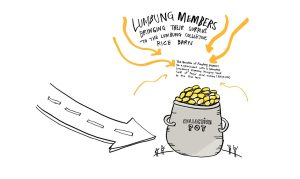At the heart of documenta fifteen is an exploration of economic experiments and economies based on lumbung, or so-called commoning, principles. Various working groups have emerged in order to examine the question: What concrete practices make it possible to build a collective arts economy, anchored in the local and based on lumbung values such as humor, generosity, independence, transparency, sufficiency, and regeneration? These working groups are ways of building a long-term lumbung: a barn of collective resources that are shared to enhance the sustainability of artists collectives all around the world.
Since October 2020, the 14 lumbung members and the Artistic Team of documenta fifteen have come together in a working group called lumbung Economy. Here, they discussed what a long-term lumbung Economy would look like, based on their specific experiences and values—inspired by locally anchored cultural and economic practices such as lumbung in Indonesia, Maaya in Mali, and Buen vivir in Central and South America.
From these discussions, that are also informed by the rich knowledge on collective governance and organisation of many lumbung artists and lumbung members, a collective lumbung Economy has started to grow. This economy has been the basis for the way documenta fifteen has been created: through smaller and big assemblies, called mini majelises and majelis akbar, and through a constant sharing of resources such as knowledge, solidarity, care, problems, networks, and (production) budgets. At the core of the lumbung Economy are several working groups: lumbung Kios, lumbung Gallery, lumbung Land, and lumbung Currency.
They act as concrete mechanisms to generate unrestricted resources for a longer term lumbung building—or, in other words, to transvest money from the classical exhibition economy towards the commons-based lumbung Economy. By testing sustainable, alternative economic models, the working groups are an important part of a practice that is intended to continue and be effective beyond the 100 days of documenta fifteen.
The working groups
lumbung Kios
lumbung Kios is a network of decentralized and self-run Kios (Indonesian for kiosk), in order to sell products at different locations. Its mission is to create a sustaining model to raise an income through the sales of goods produced by the lumbung members, lumbung artists, and their local ekosistems. lumbung Kios is an attempt to decentralize distribution mechanisms and to explore alternative, sustainable economies. The aim is to keep the environmental impact as low as possible.
For this reason, lumbung Kios partly tries to experiment with the Feral Trade model as a mechanism to distribute the products. Feral Trade is a slow trade mechanism invented by the artist Kate Rich. In this process, goods pass from hand to hand determined by the routes individuals travel. This way of trading suggests a way for distributing products by using the already existing mobility network.
More on lumbung Kios.
lumbung Gallery
lumbung Gallery creates a collectively governed, non-speculative, and regenerative gallery model. Using the parameters of existing art economies it aims to “transvest” resources towards a more commons based economy following the lumbung values. lumbung Gallery is also considered a tool and learning program enabling similar initiatives around the globe.
During and after the 100 days of documenta fifteen, many artworks by the lumbung members and lumbung artists can be supported front stage in Kassel at ruruHaus. Additionally, artworks will be available for viewing on the online platform of the lumbung Gallery in collaboration with TheArtists.
The pricing of the artworks is based on the collective’s basic needs and the artists’ basic income in addition to production costs and other material condition variables rather than speculative market prices. lumbung Gallery also works to create commitment to or selling of non-object based artworks, or artworks that stay with a community. With this, there will also be non-monetary exchange, as well as affordable artworks.
More on lumbung Gallery.
lumbung Land
Land is one of the most fundamental approaches to the lumbung Economy. It is a space where a community has agency, can govern resources collectively and build a lumbung value based economy and independent artistic practice. Many lumbung members are, however, confronted with issues such as land grabbing, climate injustice, or lack of resources to acquire land, which harms their sustainability and their autonomous artistic practices.
The lumbung Land working group looks into holistic models for handling land. It experiments with land development concepts that are inclusive to human and non-human, regenerative, community-governed, and which adopt a holistic approach, combining culture, agriculture, and ecology. The lumbung is working on a land school which develops a rotational fund, and shares the learnings from land or soil based practices such as the New Rural Agenda by Jatiwangi art Factory in Indonesia, those by INLAND in Spain, or from the farm that is being developed by Wajukuu Art Project outside Nairobi.
Also, throughout the 100 days a multitude of works and programs around land can be seen or attended. They question land ownership, retrace memory, bring music, and tell stories around land, building on the post-human approach to soil and land.
lumbung Currency
lumbung Currency looks to strengthen and connect the various community currencies that are being built by four of the lumbung members, such as the BeeCoin (ZK/U—Center for Art and Urbanistics), the Cheesecoin (INLAND), the Dayra (The Question of Funding), and the Temu Jalar (Gudskul). Community currencies could enable the lumbung to develop its own economic exchange system where value is decided upon by the community, and exchange happens from direct needs and values.
Several learning sessions, amongst others with Grassroots Economics as well as with Paul Seidler and Steph Holl-Trieu, led into the existing currency plans of the lumbung members. The development processes of the currencies is partly on view in the exhibition in Kassel. After documenta fifteen, when the individual currencies have come to fuller life, the lumbung intends to work on ways of connecting the currencies to each other to enable value exchange between local communities outside of often inflexible and bureaucratic mainstream banking and accountability systems.


